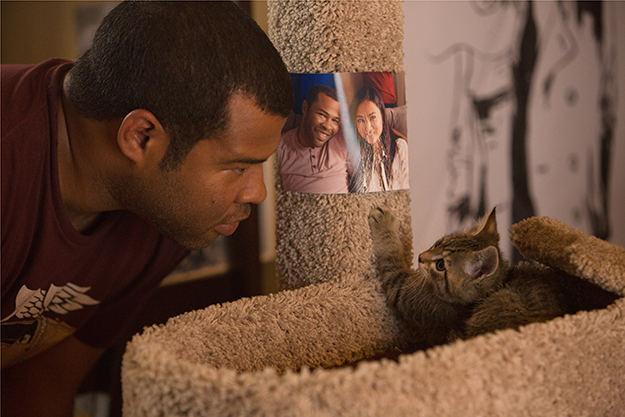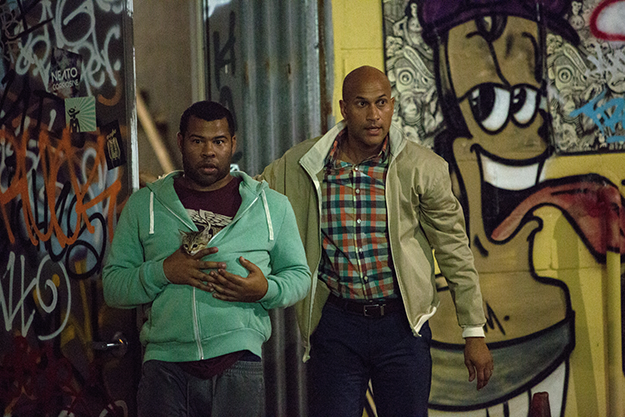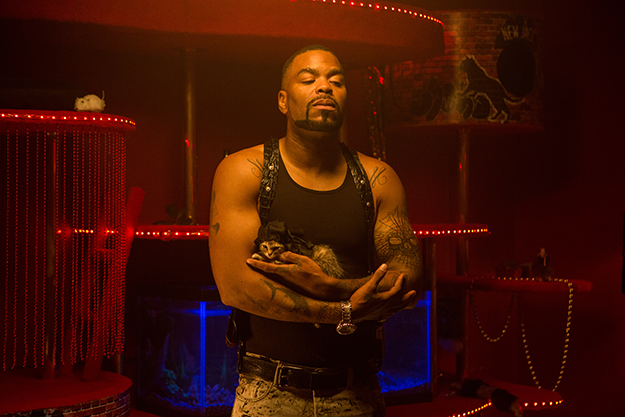Review: Keanu
I laughed throughout Keanu with the audience, and when it was over, I was left wanting more. Not because it was so good, but because I was hoping for more. I should make a Shepard Fairey–style Hope poster picturing the Keanu trio (oh, I guess I can) because it is difficult not to link Key & Peele to their best-known characters, Barack Obama and his anger translator, Luther. The popular comics are also cultural translators who initially emphasized their biracial heritage and ability to “code switch” tactically (in the way that Obama is politically strategic) creating depictions of urban poor, suburban, middle- and upper-middle-class blacks, and bringing racially inflected humor that appeals to a Comedy Central–centric audience who, I would argue, want to believe that the duo transcends race. While Key & Peele minor in mixed-race, they major in and identify with blackness, and often their sketches and characters grapple with representations of African American men and women and people of color, with black acting and acting “black.”
Who is the intended audience for Keanu? If it’s for the duo’s loyal fans, the movie is disappointing yet fun; if the film strives to introduce the team to a wider audience, it’s also fun but doesn’t begin to display their talents; and if it’s directed at children, the almost Tarantino-level slinging around of the n-word makes it a hot mess. But is Keanu a parody of Tarantino? If so, the references are far too subtle, and for Wendell-level superfans the absence of cinema references that they evoke so well in the show will be jarring. I was hoping for Martin & Lewis, or madcap and strange Olson and Johnson, but, like some liberal white folks who voted for Obama, were my expectations too high?
Keanu is a weirdly (strategically?) generic fish-out-of-water tale, where bungling cowards impersonate tough guys, familiar territory for male comedy duos past and present. Key and Peele play their familiar, nerdy suburban characters that we know from the TV show. Clarence (Keegan-Michael Key) is the mild-mannered people-pleaser, a married man employed as a corporate team builder, who drives a family van and wears a windbreaker. Clarence needs “me time” to find his inner roughneck because his child thinks he’s an embarrassment, and his desirable wife (Nia Long) finds him socially boring and sexually passive. Jordan Peele as Rell, Clarence’s cousin, is a single, stoner artist and graphic designer who’s out of work, and as the film opens, suffering over a break-up. This is where Keanu, played by a team of seven kittens—and there are not enough emoticons to describe just how cute they are—steps in filling the hole in his heart and becoming Rell’s artistic muse. Emotionally and creatively renewed, Rell embarks on a calendar shoot of Keanu dressed as iconic film characters posed on tiny sets (à la Harry Whittier Frees, the Victorian kitten photographer?) for movies like The Shining and Point Break.
The kitten gets “catnapped,” falling into the hands of the 17th Street Blips, a savage gang of former Bloods and Crips whose purple gang colors are a blending of red and blue. Tipped off to Keanu’s possible whereabouts by Rell’s old-skool-loving dealer, Hulka (a cornrowed Will Forte), the cousins pursue the beloved feline into the urban underworld of L.A. (actually, the film was shot in New Orleans) by clumsily but surprisingly effectively passing as the murderous “Allentown Boys” to convince threatening gang leader, Cheddar (Method Man), and his capo, Hi-C (comedian Tiffany Haddish), to sell them the kitten. Over the course of the night they discover their inner (n*gga) badass, bonding with the Blips and battling drug kingpins and a monstrous crime duo (also played by Key & Peele) for the coveted kitten.
There is only a single comic narrative setup and extended joke in Keanu, which is part of the problem with the film. I enjoyed watching it, and Key & Peele are both appealing on the big screen, and there were lots of laughs via comical encounters familiar from their show with stuffy neighbors, gangbangers, Hollywood Hills addicts (led by Anna Faris), drug kingpins along with requisite L.A. car chases and violent gunplay, but overall it felt declawed. There’s nothing we haven’t seen before—except for the kitten. K&P’s Liam Neesons–obsessed valets would love the action, but I doubt their heads would explode as usual. And the Movie Talkers would excoriate the film, I suspect.
Helmed by Key & Peele’s regular director, Peter Atencio, Keanu plays like a feature-length TV sketch. Considering the filmic, one-camera shooting style that distinguishes the TV show, and Rell’s fixation on movies, Keanu is not very cinematic and completely non-self-reflexive. Rarely does the editing intersect with the comedy, though one good example was an overabundant series of camera angles of Clarence as he breaks down the backstory of George Michael and Wham!. The production feels televisual, staged in enclosed spaces like cars, clubs, and rooftops. The cousins visit the kind of urban spaces explored in their program: The Club, strip joints, back alleys, and vacant lots. But the ‘hood and the neighborhood are flat, missing both the playful surrealism that animates these quotidian urban and suburban spaces and the eccentric characters that occupy them in the show: the husbands who ascend into outer space in order to call their wives bitches out loud, or the dank, ghetto apartment of drug-addled friends, Cedric and Levi, whose “gangsta pet” rat, Ratatouille, makes sandwiches for guests (albeit with his own droppings).
There’s no doubt that Key & Peele can act outside of their signature characters (even as the press kit mentions their plans for a film based on the substitute teacher sketch). Similar to classic Hollywood comedy couples like Laurel and Hardy, Hope and Crosby, or Wheeler and Woolsey, the combination of the pair’s individual personalities plus their intense friendship draws you in. But here the boys play it straight, and as cousins, there is little frisson between them. Absent is the sense that their bromance supersedes all their other romantic and sexual relationships, which in the TV show becomes manifest by the two playing actual couples (straight like Meegan and Andre, or gay husbands, LaShawn and Samuel).
Keanu has potential but Key & Peele depend too much on the code-switching shtick that grew a little tiresome, while neglecting their black nerdiness. However, I admire that similar to Obama’s Luther, the team work to translate representations of black masculine anger and impenetrability into comedy, revealing the adorable kittens underneath the swagger. And finally, even though my hopes for Keanu were Magical Negritude in scale, my guilty pleasure in rappers/actors was satisfied. Only a solid, confident thespian, like Method (Acting) Man could defy the adage of avoiding performances with children or animals yet not be upstaged by the tiny napping kitten (in a do-rag) snuggled in his arms.
Ina Diane Archer is an artist and filmmaker living in Brooklyn. She is the co-chair of NYWIFT’s Women’s Film Preservation Fund and she is pursuing an MA in Moving Image Archiving and Preservation at NYU.






